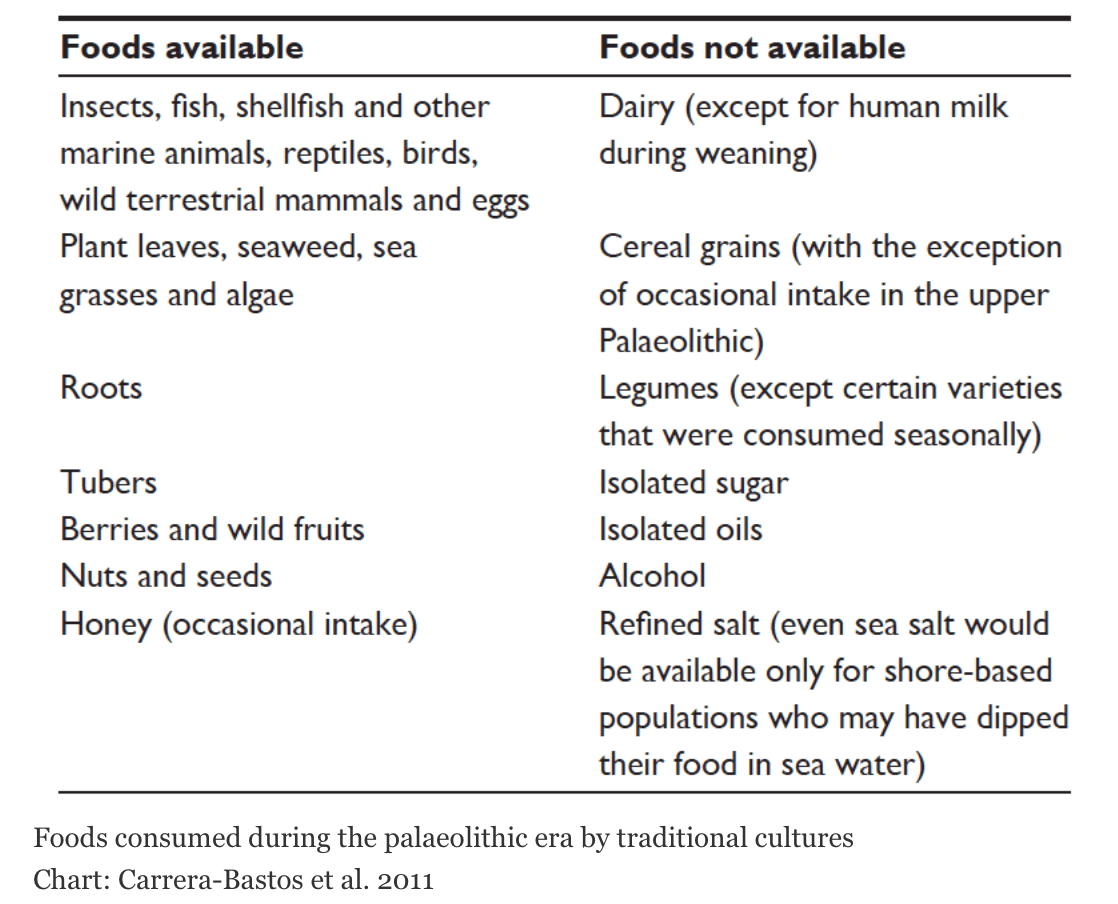
YOUR FITNESS BLOG
How Did Our Paleo Ancestors Live?
Reality Check
In Scotland, around two million people, 40% of the Scottish population, have at least one long-term condition, a figure that builds each year. The World Health Organisation (WHO) indicates that globally today almost 45% of all chronic disease deaths occur prematurely, under the age of 70. With the rate of chronic disease continuing to rise rapidly around the world, many countries, including Scotland, do not have the financial or human resources to effectively identify, manage or prevent these diseases.
Importantly, there are clear links indicating that behavioural choices such as diet and lifestyle contribute strongly to the acquirement of chronic diseases such as cardiovascular disease (CVD), cancer, type II diabetes and obesity. This blog post argues that the adoption of diet and lifestyle of the Modern Age, and specifically after the Industrial Revolution, have largely contributed to the dramatic increase in chronic degenerative diseases. Also, if the human population is to minimise the risk of chronic diseases there is an urgent need to revert back to pre-agricultural eating and lifestyle patterns.
There is ample evidence to suggest that most of the human genome is composed of genes selected during the Palaeolithic Era, a period that lasted approximately 2.5 million years ago to 11,000 years ago. It was paleo and traditional hunter-gatherer populations in Europe, Asia, Oceanica (islands of the tropical Pacific Ocean), and the Americas that inhabited the earth during this period and there is strong evidence to suggest these populations exhibited superior health when compared to humans today.
Health Status of Pre-Agricultural Cultures
With the help of anatomical, biomechanics, and isotropic analyses of various human skeletons around the world and studies of hunter-gatherer societies, we know that paleo and traditional hunter-gatherers cultures that lived during the Palaeolithic Era exhibited a number of similar characteristics including the following:
- Regular sun exposure
- No chronic stress
- Regular physical activity, obtained from gathering food and water, escaping from predators, social interaction and building shelters
- No exposure to man-made environmental pollutants
- Universally fresh food sources
Also, scientific data reveals that our paleo and traditional hunter-gatherer populations exhibited superior health markers, body composition, and physical fitness compared with industrialised populations such as:
- Lower blood pressure in hunter-gatherers when compared against current optimal blood pressure values (<120mm Hg and <80mm Hg for systolic and diastolic blood pressure)
- Excellent insulin sensitivity
- Lower body mass index (BMI)
- Lower waist (cm) / height(m) ratio
- Lower triceps skinfold (mm), a marker of overall bodyfat
- Great maximum oxygen consumption (VO2 max), which can be used as marker for overall general fitness
- Better bone health and visual acuity
Paleo Ancestral Eating
With geological and archaeological evaluation of hunter-gatherer habits, we know the foods that were consumed during the Palaeolithic Era consisted largely of animal meats from wild terrestrial animals, marine animals (fish and shellfish), plants, seaweed, algae, roots, tubers, berries, wild fruits and nuts and seeds. These foods and their availability varied according to differences in geographic location and season, but were universally fresh and generally unprocessed.

Health Consequences of the Agricultural Revolution
The Agricultural Revolution, which began about 11,000 years ago, marked drastic and rapid transition in human diet and lifestyle that are very different from what shaped the human genome for more than 2 million years. This revolution marked the advent of farmed crops and animals and the domestication of both. Some of the more significant changes in the human diet included the consumption of cereal grains, the introduction of non-human milk, domesticated animal meats, and other cultivated plant foods, and later widespread use of sucrose (sugar) and alcoholic beverages.
However, it is was the Industrial Revolution that began about the 1760’s and Modern Age that truly brought about the greatest disruption and maladaptive changes in human health, for which we are today paying the ultimate heath consequences. The Industrial Revolution marked a shift to powered, special-purpose machinery, factories and mass production bringing about widespread production and consumption of refined vegetable oils, cereal grains and sugars. Similarly, the Modern Age brought about “junk food” in addition to environmental pollutants, chronic stress, reduced sun exposure and decreased physical activity.
Recent evidence shows that consumption of flour in the form of breads, pasta, cookies and cake, in addition to sucrose in the form of soda drinks, processed breads, and candy, and industrial seed oils like sunflower oil and safflower oil found in processed, packaged foods are largely to blame for the global chronic disease epidemic. More recently, the consumption of high fructose corn syrup (HFCS) found in soda drinks and many salad dressings have increased fructose consumption to alarming levels, which evidence shows contributes to a growing diseased population. These modern foods containing flour, sugar and industrial seed oils promote low-grade, chronic inflammation in our bodies, which is underlying cause of all modern diseases like cardiovascular disease, autoimmunity and obesity
Counterarguments
A common counterargument against evidence suggesting our paleo ancestors lived in superior health is life expectancy. Opposition would argue that the life expectancy at birth of paleo or traditional hunter-gatherers populations was significantly shorter than humans of today. However, this marker is greatly influenced by a number of factors that must be corrected between periods to ascertain a true measure of life expectancy. For instance, warfare, infections, exposure to elements, and high childhood (infant and adolescent) mortality were all contributors of increased mortality during the Palaeolithic Era. Today, average life expectancy is higher, but not because of healthier eating and lifestyle but due to better sanitation, vaccination, antibiotics, medical care including emergency surgeries, quarantine policies, political and social stability and less physical trauma.
In fact, a recent examination of the mortality profiles of paleo hunter-gatherer populations found that adults of this period lived between 68-78 years, and that it was not uncommon for people during this time period to reach these ages. More importantly, this population would live to 60 years of age or more without any signs or symptoms of chronic degenerative disease. Fossil records show that hunter-gatherer health and lifespan declined only when the transition was made to agricultural based foods and lifestyle.
Conclusions
What does this information tell us? As a human population, we keep moving further away from our traditional ancestral environment that bought us superior health. On an evolutionary timescale, these changes in our eating patterns and lifestyle are too recent for us humans to have adapted. The foods and lifestyle we largely adopt today bring us deeper into a civilization of epidemic disease and we must understand that this regression in health is well within our control. Teaching our clients about proper nutrition entails educating them about the human evolutionary time scale and the dangers of large consumption of modern, processed foods. Of greatest importance is that our clients learn to adopt eating patterns emphasising primarily nutrient-enriched, unprocessed foods at the expense of refined vegetable oils and sugars, cereal grains and processed foods. It is precisely through these adopted changes in eating that our clients learn to better their health and minimize the risk of acquiring chronic disease.
For more information on our services please click here to read more.
References
Angel, L.J. (1984) Health as a crucial factor in the changes from hunting to developed farming in the eastern Mediterranean. In: Cohen MN, Armelagos GJ, editors. Paleopathology at the Origins of Agriculture. Orlando: Academic Press;:51–73.
Campbell, M.C., and Tishkoff, S.A. (2010). The Evolution of Human Genetic and Phenotypic Variation in Africa. Current Biology: CB, 20(4), R166–R173. doi:10.1016/j.cub.2009.11.050.
Carrera-Bastos, P., Fontes-Villalba, M., O’Keefe, J.H., Lindeber, S. and Cordain, L. (2011) The Western Diet and Lifestyle and Diseases of Civilization. Research Reports in Clinical Cardiology. 2,pp15-35.
Cordain, L., Gotshall, R.W., Eaton, S.B. and Eaton, S.B. (1998). Physical activity, energy expenditure and fitness: an evolutionary perspective. International Journal of Sports Medicine. 19(5):328–335.
Eaton, S.B., Cordain, L. and Lindeberg, S. (2002) Evolutionary health promotion: a consideration of common counterarguments. Preventative Medicine. 34(2): 119–123.
Eaton, S.B., Konner, M. and Shostak, M. (1998) Stone agers in the fast lane: chronic degenerative diseases in evolutionary perspective. American Journal of Medicine. 84(4):739–749.
Gurven, M. and Kaplan H. (2007) Longevity among hunter-gatherers: a cross-cultural examination. Population and Developmental Review. 33:321–365.
Lindeberg, S., Nilsson-Ehle, P., Terént A, et al. (1994) Cardiovascular risk factors in a Melanesian population apparently free from stroke and ischaemic heart disease: the Kitava study. Journal of International Medicine. 236:331–340.
McDougall, I., Brown, F.H. and Fleagle, J.G. (2005) Stratigraphic placement and age ofmodern humans from Kibish, Ethiopia. Nature. 433:733–736.
Oliver, W.J., Cohen, E.L. and Neel, J.V. (1975) Blood pressure, sodium intake, and sodium related hormones in the Yanomamo Indians, a “no–salt” culture. Circulation. 52(1):146–151.
Pritchard, J.K. (2010) How we are evolving. Scientific America. 303(4):40–47.
Ray, N., Currat, M., Berthier, P. and Excoffier, L. (2005) Recovering the geographic origin of early modern humans by realistic and spatially explicit simulations. Genome Research. 15:1161–1167.
The Scottish Government (2013) Long Term Conditions. Retrieved from: http://www.gov.scot/Topics/Health/Services/Long-Term-Conditions
Tishkoff, S. and Williams S. (2002) Genetic analysis of African populations: human evolution and complex disease. Nature Reviews Genetics. 3:611–621.
Vieth, R. (2006) What is the optimal vitamin D status for health? Progress in Biophysics & Molecular Biology. 92(1):26–32.
World Health Organisation (2009) Preventing Chronic Disease : A Vital Investment. Retrieved from: http://www.who.int/chp/chronic_disease_report/en/

Did you find this content valuable?
Add yourself to our community to be notified of future content.

